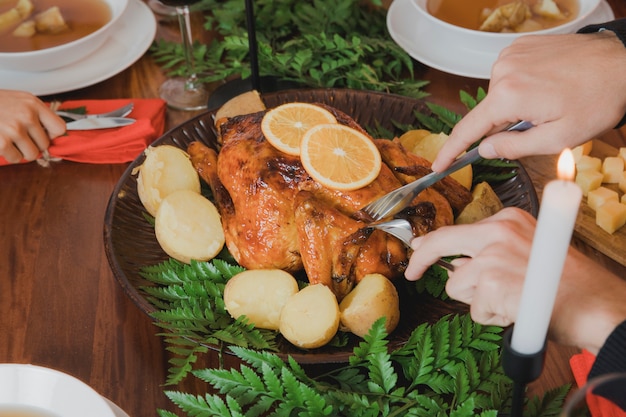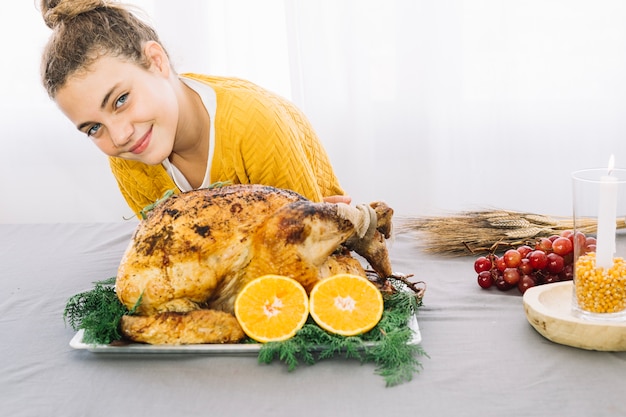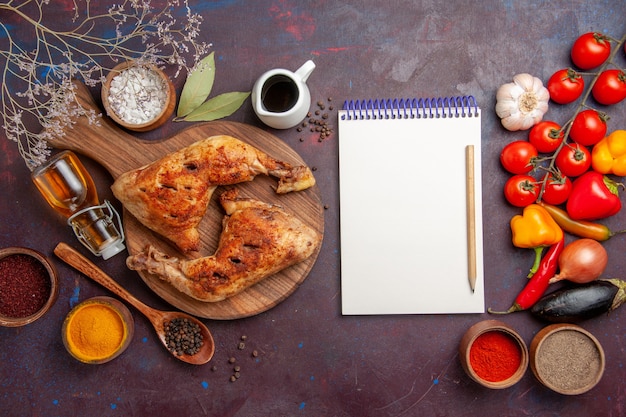In the grand culinary scheme, chicken thighs are often overshadowed by their leaner, more 'fashionable' counterparts - chicken breasts. But let me tell you, this is a grave injustice. Chicken thighs, with their rich, succulent texture and forgiving nature, are the unsung heroes of the poultry world. And when you cook them at 425 degrees, they truly reach their full potential, transforming into a symphony of crispy skin and juicy meat.
(Part 1) A Love Affair with Chicken Thighs

My love for chicken thighs goes back years. I remember the first time I tasted a perfectly cooked thigh – it was a revelation. The skin was crispy, the meat was tender, and the flavors were just bursting. It was a love affair at first bite.
The Science of Succulence
Now, there’s a reason why chicken thighs are naturally more flavorful and juicy than their breast counterparts. They’re packed with a higher fat content, which renders beautifully during cooking. This fat adds moisture and a rich, savory depth to the meat. But it's not just about fat; it's about the structure. Chicken thighs have a denser, more forgiving muscle structure, which makes them less prone to drying out. It's like a built-in insurance policy against overcooked, dry chicken.
(Part 2) The 425 Degree Advantage: High Heat, High Rewards

Okay, so we've established that chicken thighs are inherently amazing. But let's talk about the 425-degree magic. Why this temperature? Because it's the perfect recipe for creating that coveted crispy skin and tender, juicy interior. Think of it as a culinary balancing act, with the high heat acting as the maestro, orchestrating a beautiful symphony of flavor and texture.
Harnessing the Power of High Heat
Now, some people might think that 425 degrees is too high for chicken. But, trust me, it's all about technique. When done right, it's the key to unlocking the full potential of your chicken thighs. It’s like a controlled explosion of flavor, creating that gorgeous golden-brown crust that makes your mouth water.
The high heat also promotes faster cooking, which is essential for preventing the meat from drying out. You're aiming for a quick, even cook, and 425 degrees does exactly that. Think of it as a culinary sprint, where the chicken thighs race to a delicious finish line.
(Part 3) The Art of Preparation: A Foundation for Flavor

Now, let’s get down to the nitty-gritty of prepping those chicken thighs. It's not just about throwing them in the oven; it's about building a foundation for flavor and ensuring a perfect cook.
Patting Dry: The Key to Crispy Skin
This might seem like a small detail, but patting those chicken thighs dry with paper towels is a crucial step. It's the difference between a passable chicken thigh and a truly magnificent one. Why? Because excess moisture creates steam, which prevents the skin from crisping up. It's about creating a dry surface for the skin to adhere to, allowing it to achieve that coveted golden-brown crust. Think of it like building a house – you need a firm foundation for a beautiful structure.
Seasoning with a Purpose: The Flavor Symphony
Now, this is where the fun begins. Seasoning those chicken thighs is a creative act, a way to paint a flavor profile that tantalizes the taste buds. Here's my go-to recipe, a symphony of flavors you can easily adapt to your own preferences:
- Salt and Pepper: The cornerstone of any good seasoning. Don't be shy – use a generous amount. Salt brings out the natural flavors of the chicken, making it taste more delicious.
- Garlic Powder: A touch of pungent, savory magic that adds a depth of flavor and aroma.
- Paprika: This spice adds warmth and depth, giving your chicken a touch of complexity. You can use sweet paprika for a milder flavor or smoked paprika for a more intense, smoky note.
- Dried Herbs: This is where you get to express your creativity. Think thyme, rosemary, oregano, or even a sprinkle of dried basil. They add a fragrant touch that elevates the chicken to new heights.
For an extra kick, you can try adding a pinch of chili powder or cayenne pepper. Experiment with different combinations of spices to find your perfect flavor profile.
(Part 4) Cooking Time: A Balancing Act of Temperature and Time
Now we’re getting to the heart of the matter – cooking time. This is where things can get a little tricky, but don't worry, I've got you covered. The cooking time for chicken thighs at 425 degrees depends on several key factors:
Size Matters: Big or Small, It All Makes a Difference
Think of it like this: a marathon runner needs more time to complete the course than a sprinter. Larger chicken thighs, like marathon runners, need a bit more time to cook through. Smaller thighs, like sprinters, will be ready in a flash. As a general rule of thumb, it's better to err on the side of caution and give those larger thighs a few extra minutes in the oven.
Thickness: The Key to Uniformity
Imagine a group of swimmers, each with varying levels of experience. Those who are thicker in the middle, like experienced swimmers, need a longer swim to reach the finish line. Thinner swimmers, like novice swimmers, will reach the finish line quicker. It's the same with chicken thighs. Thicker thighs, like those experienced swimmers, require a longer cooking time. Thinner thighs, like novice swimmers, will cook faster.
Oven Variations: Finding the Sweet Spot
Every oven is like a unique snowflake, with its own personality and quirks. Some ovens run a bit hotter or colder than others, so be prepared to adjust cooking times based on your oven's quirks. It's like finding the sweet spot for a musical instrument – you need to experiment to find the perfect tuning for your oven.
The best approach is to start with a slightly shorter cooking time and then check the chicken's temperature with a meat thermometer to see if it's ready. If it's not quite done, just pop it back in the oven for a few more minutes.
(Part 5) The internal temperature: A Culinary Thermometer
Here’s the deal: the USDA recommends an internal temperature of 165 degrees Fahrenheit for cooked chicken. However, that can sometimes lead to dry, overcooked chicken. My advice? Aim for a slightly lower temperature, around 160 degrees Fahrenheit. This will ensure that the chicken is perfectly cooked through without sacrificing any juiciness.
The Truth About Color: Trust the Thermometer
You might think you can tell if chicken is cooked by looking at the color, but that's not always reliable. Color is a misleading indicator, especially with chicken thighs. A meat thermometer is the most accurate way to determine if the chicken is cooked through. It’s like a culinary detective, providing irrefutable evidence of doneness.
Insert the thermometer into the thickest part of the thigh, making sure not to touch any bone. If the temperature reads 160 degrees Fahrenheit, you've got a culinary masterpiece in the making.
(Part 6) Rest Time: A Moment of Relaxation
You've just created a culinary triumph, but don't rush to devour those chicken thighs. They need a little time to relax and savor their victory. Allowing them to rest for about 5-10 minutes will help the juices redistribute throughout the meat, resulting in a more tender, flavorful experience. Think of it as a spa day for your chicken.
The Power of Redistribution
I know it's tempting to slice into those crispy thighs right away, but resist! Those juicy juices will escape if you slice them too soon. Resting allows those juices to redistribute evenly, ensuring that each bite is bursting with flavor. It's a small act of patience that pays off big time.
(Part 7) The Perfect Companion: Roasted Vegetables
Let's face it, chicken thighs are amazing on their own, but they reach a new level of culinary excellence when paired with a side of roasted vegetables. The high heat of the oven transforms simple vegetables into flavor-packed companions that complement the chicken beautifully.
Roasting 101: A Symphony of Textures and Flavors
Here's how to roast vegetables to perfection:
- Cut to Size: Cut your vegetables into bite-sized pieces. This allows for even cooking and prevents some vegetables from burning before others are done. Think of it as creating a culinary orchestra where all the instruments play in harmony.
- Seasoning Magic: Don't be afraid to experiment with your seasonings. Salt and pepper are a must, but feel free to add garlic powder, paprika, or your favorite herbs to enhance the flavor. It's like adding different instruments to your culinary orchestra, creating a unique and vibrant sound.
- Toss It Up: Toss the vegetables with olive oil or another healthy fat. This helps them brown beautifully and prevents them from sticking to the pan. Think of it as creating a smooth and harmonious movement within your culinary orchestra.
- High Heat: Roast those vegetables at 425 degrees. This high heat allows the vegetables to caramelize and develop a delicious crust. Think of it as a powerful crescendo within your culinary orchestra, creating a burst of flavor.
Here are some of my favorite vegetable pairings for chicken thighs:
- Broccoli and Carrots: A classic combination that's always a hit.
- sweet potatoes and Brussels Sprouts: The sweetness of the sweet potatoes balances the bitterness of the Brussels sprouts, creating a delightful contrast.
- Asparagus and Cherry Tomatoes: A light and refreshing combination that's perfect for spring.
(Part 8) FAQs: Your Chicken Thigh Questions Answered
I know you've got questions. It's a big world of chicken thighs! So let's tackle those burning queries:
FAQs
| Question | Answer |
|---|---|
| Can I cook chicken thighs at a lower temperature? | Absolutely! You can cook chicken thighs at lower temperatures, but it will take longer. The recommended temperature for cooking chicken thighs is between 350 degrees fahrenheit and 425 degrees Fahrenheit. The higher the temperature, the faster the cooking time. However, you might sacrifice some of that crispy skin at lower temperatures. |
| How do I know when my chicken thighs are cooked through? | The best way to know when your chicken thighs are cooked through is to use a meat thermometer. The internal temperature should reach 160 degrees Fahrenheit. You can also check for doneness by making sure that the juices run clear when you cut into the thickest part of the thigh. However, relying solely on the color can be misleading, so a thermometer is your best friend. |
| Can I cook chicken thighs with the skin on? | Yes, absolutely! cooking chicken thighs with the skin on will give you a crispy and flavorful crust. However, if you prefer skinless thighs, you can still achieve a delicious and juicy result. Just be aware that you might miss out on the crispy skin element. |
| How long should I cook chicken thighs at 425 degrees? | The cooking time for chicken thighs at 425 degrees varies depending on the size and thickness of the thighs. As a general rule of thumb, smaller and thinner thighs will take about 20-25 minutes, while larger and thicker thighs may take up to 30-35 minutes. Always check the internal temperature with a meat thermometer to ensure the chicken is cooked through. |
| Can I use any type of chicken thighs? | You can use bone-in or boneless, skin-on or skinless chicken thighs for this recipe. However, if you're using boneless and skinless thighs, you'll want to adjust the cooking time accordingly. They will cook much faster than bone-in thighs, so keep a close eye on them. |
There you have it! My ultimate guide to cooking chicken thighs at 425 degrees. Now go forth and unleash your inner culinary genius. Enjoy your crispy, juicy, and flavorful creations!
Everyone is watching

Corn on the Cob: The Ultimate Guide to Perfectly Cooked Ears
Healthy MealsAh, corn on the cob. Just the name evokes images of sunny days, barbecues, and that sweet, juicy flavour that ...

Scallops: The Ultimate Guide to Perfect Cooking
Healthy MealsAh, scallops. Those delicate, sweet, and utterly delicious morsels of the sea. They hold a special place in my...

Spaghetti Squash: The Ultimate Guide to Cooking and Serving
Healthy MealsRemember that time you saw spaghetti squash at the supermarket, looking all bumpy and strange, and thought, "W...

Salmon Cooking Times: Perfect Guide for Every Recipe
Healthy MealsLet me tell you, cooking salmon is an art form. It's all about getting that perfect balance: juicy and tender,...

Ham Cooking Time: How Long to Bake, Smoke, or Boil a Delicious Ham
Healthy MealsAh, ham. It's a classic, isn't it? A real crowd-pleaser, especially around holidays. And when done right, it'...
